
(auf Karte anzeigen)
12:15UTC+2

13.08.201911:45UTC+2
Atlantic Crossing with little kids
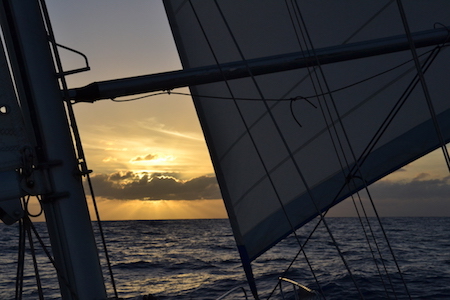
Summary
Together with our 2 and 4 year old boys, we crossed the Atlantic ocean in 19 days. As a family of four we started our crossing in Mindelo, Cape Verde and made landfall in Martinique after a quiet passage. Wind and seas have been light to moderate throughout the passage and trade winds were not yet up to their full force by the beginning of December. Winds were almost to calm during the first week of the crossing. During our passage we took a more southerly route aiming to find more sustainable winds and finally hit the trades after 8 days. En route we encountered multiple squalls with heavy rain and increased winds gusting up to 25-30 knots. Living on board was enjoyable and worked well with the kids. After 2237 nautical miles we gladly arrived in Martinique and herein report our crossing experience.
Preparations
Fuel, Water & Gas
Prior to departure we made sure that our fuel and water tanks are full and cooking gas was available for several weeks.
Provisioning
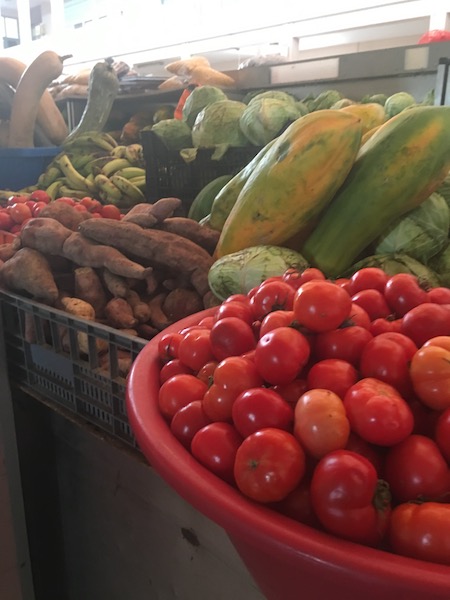 We obtained fresh produce from the market municipal in Mindelo. There is a second market with less stocks but which is supposed to be cheaper close to the fish market, which we note unfortunately too late. The market municipal has fresh produce from the farmers from Santo Antao and is of good quality. We bought oranges, papaya, bananas, peppers, avocados, cucumbers, pumpkin, potatoes, sweet potatoes, onions, coconut, egg plant, eggs and cabbage. Selection is more restricted as compared to Europe. Some imported goods e.g. apples, carrots or ananas can be obtained in addition in the local super markets, but these goods have been cooled before, thus will quickly waste if not stored in the fridge. We bought few of these, but could not store them in the fridge, thus had to eat them quickly.
We obtained fresh produce from the market municipal in Mindelo. There is a second market with less stocks but which is supposed to be cheaper close to the fish market, which we note unfortunately too late. The market municipal has fresh produce from the farmers from Santo Antao and is of good quality. We bought oranges, papaya, bananas, peppers, avocados, cucumbers, pumpkin, potatoes, sweet potatoes, onions, coconut, egg plant, eggs and cabbage. Selection is more restricted as compared to Europe. Some imported goods e.g. apples, carrots or ananas can be obtained in addition in the local super markets, but these goods have been cooled before, thus will quickly waste if not stored in the fridge. We bought few of these, but could not store them in the fridge, thus had to eat them quickly.
Groceries can be obtained in multiple small supermarkets close to the marina. Selection is limited, thus we were lucky, that we could still live on our goods we already stocked up in the canary islands. Additionally we bought flour, pasta, rice and instant soup which is basically available everywhere. We obtained a limited amount of meat (chicken and beef) from the supermarkets, but could only carry little given the size of our fridge and the fact that we don’t have a freezer on board.
We washed and stored away fresh produce in vegi nets in and outside as well as into the bilge. We learned on passage that the net outside is not well enough protected from the sun, thus not ideal for storage. Also the bilge is not ventilated well enough, thus potatoes started to rot. While we had read a lot about preserving butter, cheese and meats at ambient temperatures, we did not do this as our fridge had sufficient capacity and we expected to be able to get respective goods once we arrived in the Caribbean. Flour, rice and cereals we seals in vacuumed bags.
Deck adjustments
We safely stored lines and fenders away under deck as we would not need them for some time. We also deflated our dingy and stored it inside to have more room for working with the sails at the bow, where the dingy usually is located. All screws were checked from our wind vane and a safety line on each side of the boat was installed from the bow to the stern.
Weather
Making use of good internet coverage we downloaded two weeks weather forecasts across the Atlantic ocean. We primarily used Grib files calculated by the GFS model (NOAA) and checked wind, currents, swells and CAPE index. We also double checked data on windy.com, which also computes data from the supplementary European weather model. As windy files cannot be used offline, we performed screen shots for every day until the end of the forecast. Both file sets have been the basis for our weather routing, which we performed ourselves based on Grib files and expected boat speed.
Rigg & Engine Check
Few days prior departure Christian went up the mast and performed a full check of our rigging including stays, lines, toggles and sails. We also had our genoa UV protection repaired before setting off. The engine was checked for oil, cooling water and whether a maintenance interval was due.
Communication
We informed our family and friends about our ocean passage and shared off score contact details. Moreover Christian checked in the SSB ocean network Intermar to inform them about our plans. Also we activated our satellite phone.
Safety equipment
Prior to departure we checked that our grab bag was ready to go and renewed water and food contents. We also had a quick look on our flares and the life raft expiry dates. On deck we installed two security lines running from the bow to the stern, enabling working at the mast and front deck without untying.
Clearance
Finally we needed to get outbound clearance from immigration and the policia maritime who issued our international zarpe. We acquired clearance on Friday already as we left cape verde on Saturday and offices were closed on the weekends.
Passage Making - Generals
Communications
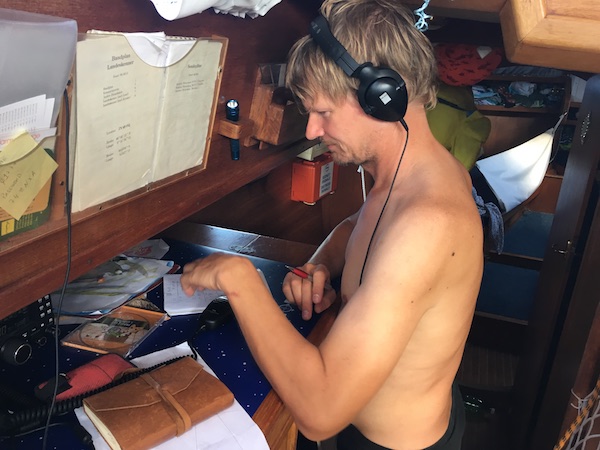 During our passage Christian remained in constant contact with SSB radio network intermar, who followed our passage across the ocean. We also regularly uploaded files to our electronic logbook on our website via SSB radio and received email (text only). But most importantly, we downloaded passage weather as GRIB files on a daily basis.
Our satellite phone was activated and switched on daily, but was not used for internet connection and mainly reserved for emergencies.
During our passage Christian remained in constant contact with SSB radio network intermar, who followed our passage across the ocean. We also regularly uploaded files to our electronic logbook on our website via SSB radio and received email (text only). But most importantly, we downloaded passage weather as GRIB files on a daily basis.
Our satellite phone was activated and switched on daily, but was not used for internet connection and mainly reserved for emergencies.
Navigation
We mainly navigated based on GPS and electronic charts on open CPN, additionally we issued navionics as backup on the tablet. Based on the daily obtained weather data we decided on the exact route to avoid areas of clams and make best use of prevailing winds. Christian measured longitude and latitude daily with our sextant as he is interested in celestial navigation.
Watches
As we are a crew of two adults only, we needed to share watches 24|7. During the day we had no fixed schedule for watches, but mostly Christian was on watch, where I played with the kids, baked, cooked and performed other house hold duties. After having an early dinner, the children went to bed usually between 7 and 8 pm. Christians first watch began, while I slept until 11 pm. From 11 pm until 2 am I was on watch and again at dawn, starting around 6 am. The children usually shared my last watch. At 9 am we had breakfast as a family.
During our watches usually the wind vane was steering the boat, except in exceptional cases when winds were so light that the vane was not working properly or in case we were running under engine, then the electrical autopilot was at the helm. Off score every 10 to 15 minutes we first (as eyes were adjusted to the dark) did a thorough watch out for navigational lights and dark clouds, then checked course, wind direction and AIS signals. In areas of traffic or in coastal waters, frequency was increased. If required we also switched on the radar (e.g. for checking for approaching squalls) or turned on the electronic compass, sonar or wind meter. Constantly, we only ran GPS, AIS and navigation lights during the night to save some energy. While we stayed most of the watch time in the deck saloon, we went outside for the look around. Between the single watch outs we spent time radioing, reading, cleaning or simply relaxing and always ran a timer reminding us for the next watch out, which was great for the peace of our minds.
If we needed to adjust sails during the night, we did adjustments if feasible during the watch shifts, in case sails needed to be reefed when winds increased both of us were required on deck, this luckily did not happen too often. We generally wore life jackets and life lines when working outside.
If no special working hours occurred during the night our watch schedule offered sufficient resting time, that both of us were fit for the next day without additional naps. Sometimes especially at the beginning when I had not had my sea legs, I had an additional nap during the day. Christian luckily is more robust and less prone to sea sickness.
Wind & Swells
Winds have been very light to light during the first 8 days. Thereafter winds increased to an average of 15 kts from NE later ENE and E. Trade winds during our whole passage have not been up to their full force. West of 37 degree W we encountered multiple squalls. Squalls often came with heavy rain and winds shifted towards southern direction with gusts of up to 25-30 kts. Few hours after more powerful squalls wind were light to very light and seas confused. Swells generally were light to moderate from NE.
Fishing
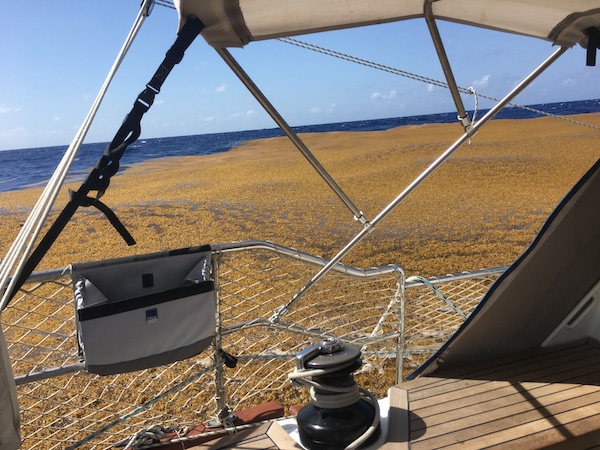 Fishing during the whole passage was difficult as we encountered floating sea weed every day. Some days the sea wheat was so abundant that it formed thick carpets on the ocean surface and made any fishing attempt in vain. It also entangled in our windvane and reduced its steering ability. During the days with less sea wheat we fished often only part of the day with a single line. We caught two mahi-mahis en route, which has definitely some
room for improvement e.g. by using better lures, increasing the number of lines and time fishing.
Fishing during the whole passage was difficult as we encountered floating sea weed every day. Some days the sea wheat was so abundant that it formed thick carpets on the ocean surface and made any fishing attempt in vain. It also entangled in our windvane and reduced its steering ability. During the days with less sea wheat we fished often only part of the day with a single line. We caught two mahi-mahis en route, which has definitely some
room for improvement e.g. by using better lures, increasing the number of lines and time fishing.
Living a board
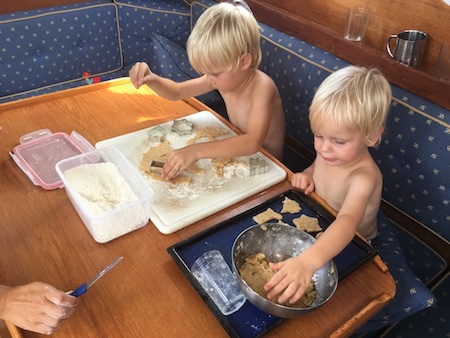 Luckily our children don’t get sea sick. Neither does Christian usually. The first two days of our passage the kids were a little tired and had an additional nap during the day, which is uncommon for them. During the first days the boys listened most of the time to audio books. Thereafter, the kids behave naturally and also securely walk through the ship in rough seas and played with their toys. I was a little nauseous the first 4 days on passage. I couldn’t read for the children, stayed outside most of the time and had an extra nap during the day. I did not take any medication apart from drinking ginger lemon tea, which calmed my stomach. As I knew that I would not have my sea legs, I pre-cooked some meals prior to departure and stored them in the fridge or in a closed pressure bowl.
After finding our sea legs, our daily routine was reading or playing board games until having breakfast together. Breakfast was mostly freshly baked bread and spread or cereals. Afterwards the boys often colored books or played lego or did role plays, while we worked with the sails, fishing lines or house hold duties. For lunch we mostly only had something light such as fruits, soup or puddings. During the afternoon we often spent time together playing, creating, being outside or the children helped making water and securing lines. For dinner I always cooked a fresh meal.
Luckily our children don’t get sea sick. Neither does Christian usually. The first two days of our passage the kids were a little tired and had an additional nap during the day, which is uncommon for them. During the first days the boys listened most of the time to audio books. Thereafter, the kids behave naturally and also securely walk through the ship in rough seas and played with their toys. I was a little nauseous the first 4 days on passage. I couldn’t read for the children, stayed outside most of the time and had an extra nap during the day. I did not take any medication apart from drinking ginger lemon tea, which calmed my stomach. As I knew that I would not have my sea legs, I pre-cooked some meals prior to departure and stored them in the fridge or in a closed pressure bowl.
After finding our sea legs, our daily routine was reading or playing board games until having breakfast together. Breakfast was mostly freshly baked bread and spread or cereals. Afterwards the boys often colored books or played lego or did role plays, while we worked with the sails, fishing lines or house hold duties. For lunch we mostly only had something light such as fruits, soup or puddings. During the afternoon we often spent time together playing, creating, being outside or the children helped making water and securing lines. For dinner I always cooked a fresh meal.
For more details about our daily routine and our adventures on the Atlantic please refer to our blog. A typical day on the Atlantic is described in day 17 - we are still not bored.
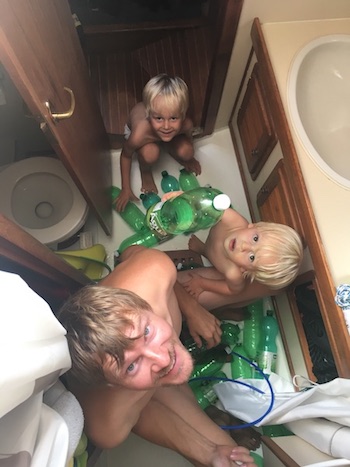
Passage Making - Along Route
Setting off - November 18
Late afternoon November 18 we attached ourselves from the pontoons of the marina mindelo and hoisted main and spinnaker in light northeasterly winds. To avoid the calms in the lee side of Santo Antao and as increased winds were predicted further souths we turned Moyas bow south. As we entered the canal between Sao Vincente and Santo Antao winds increased to 15-18 kts and we changed our sail configuration to main and genoa. After dusk winds dropped to 12 later to 8 kts, sails started to flap and boat speed reduced to 2.5kts.
Light winds & calms - November 19 - 26
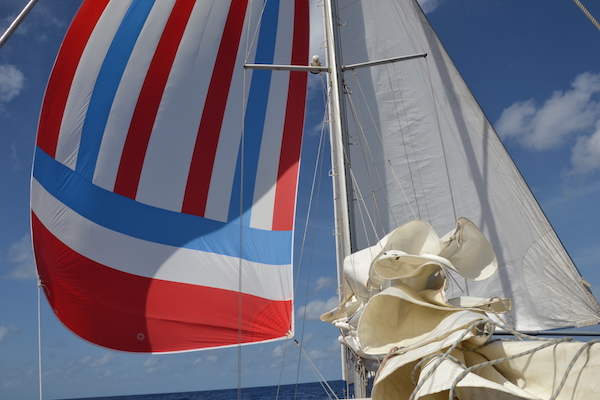 At dawn wind picked up slightly, remaining northeasterly. The next couple of days we worked hard to optimise our sail configuration to make most of the very light winds. After trying poled out genoa and main sail, main sail and spinnaker, genoa and jib as well as poled out genoa and spinnaker, we figured that genoa and hoisted spinnaker worked best for us. As we expected squalls, we mainly used this sail configuration during the day and shifted to main and genoa during the night. Due to the light wind we continued to work multiple times a day at the sails to reduce flapping. As our spinnaker entangled in our mast steps and ripped we continued sailing without a light wind sail after day 5. At days 4 and 6 wind died completely for a couple of hours, during this time we motored further south aiming for more sustainable winds. During first 8 days swells have been light to moderate to the southwest. Fair weather with sun and clear skies.
At dawn wind picked up slightly, remaining northeasterly. The next couple of days we worked hard to optimise our sail configuration to make most of the very light winds. After trying poled out genoa and main sail, main sail and spinnaker, genoa and jib as well as poled out genoa and spinnaker, we figured that genoa and hoisted spinnaker worked best for us. As we expected squalls, we mainly used this sail configuration during the day and shifted to main and genoa during the night. Due to the light wind we continued to work multiple times a day at the sails to reduce flapping. As our spinnaker entangled in our mast steps and ripped we continued sailing without a light wind sail after day 5. At days 4 and 6 wind died completely for a couple of hours, during this time we motored further south aiming for more sustainable winds. During first 8 days swells have been light to moderate to the southwest. Fair weather with sun and clear skies.
Cruising along the Trade Winds - November 27 - December 8
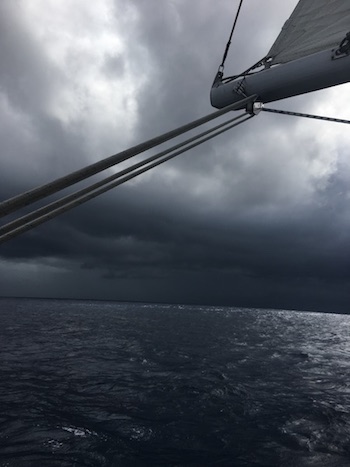 Eight days after departing from Mindelo we finally hit the trade winds 12 40
Eight days after departing from Mindelo we finally hit the trade winds 12 40N, 37 20 W. ENE winds increased to 12 later to 15 kts. As we encountered the trade winds the weather changed to overcast skies. Our first squall hit us the same day. We touched the edge of a thunderstorm and experienced multiple squalls with heavy rain and winds gusting to 25-30 knots. During the squalls wind direction always shifted to the SE to S and winds were usually light to calm a few hours afterwards, whereas seas were confused. Once we hit the trade winds we sailed mainly with poled out genoa, jib on the baby stay as well as reefed main. During the night we usually took the 2nd reef of our main sail. As the genua can be easily reefed by the furlex system, we set the full genoa until we hit a squall. Even during the night squalls can be often spotted due to the dark clouds and confirmed by the echos of the rain via radar. Generally winds further west backed more to the east and swells got a little larger. Conditions also in the trade winds were moderate at the most and trade winds were not at their full strength yet.
Landfall in Martinique - December 8
3 pm December 8 we spotted Martinique to the west. After rounding the southern edge of the island and the fish nets in front of the Ilet Cabrits we sailed into the Passe du Marin accompanied by heavy rain and increased winds of our first squall in the Caribbean. Just before 6 pm Moya was safely tied up in the large marina Marin. Marin is an ideal landfall after crossing the Atlantic as it has candleries, sail repair shops, boating stores as well as good facilities for re-provisioning.
A few numbers
- Passage duration - 19 days from Sao Vincente to Martinique
- Mileage sailed - 2152 nm
- Mileage motored - 85 nm
- Days with light winds & calms - 8 (first half)
- Average boat speed in light wind zone - 4.15 kts
- Average wind speed in light wind zone - approximately 9 kts
- Days in the trade winds - 11 (second half)
- Average boat speed in trade wind zone - 5.45 kts
- Average wind speed in trade wind zone - approximately 15 kts
- Best etmal - 144 nm
- Favorable current - none
- Fish landed - 2; fishing most of the time was not possible due to floating sea weed
- Days with fresh products - 19
- Produced water on passage - 497 Liters
- Average water used per day (person) - 34 Liters (8.5 Liters)